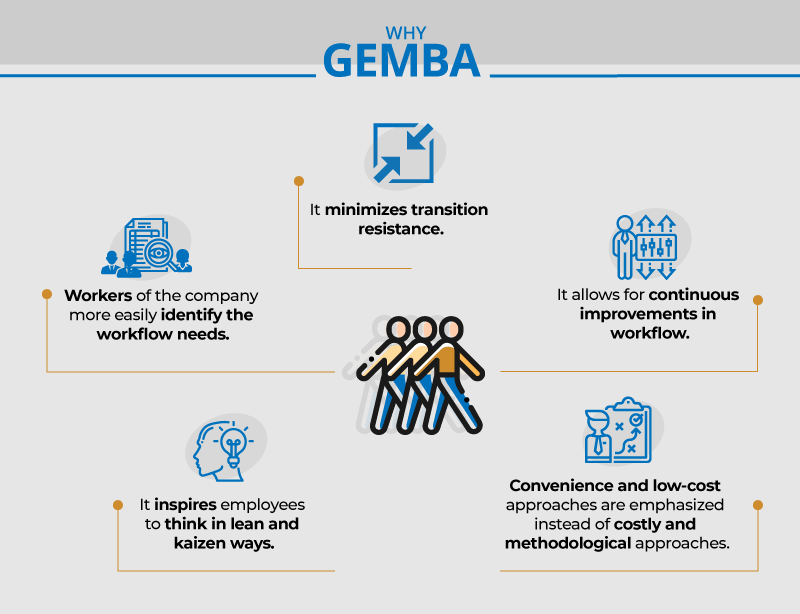Walk like a boss - Do the Gemba walk
“There is a difference between knowing the path and walking the path.”
Gemba in Japanese (現場, also Genba) means the "Real Place" or "Actual Place." Back in 1995 - January to be precise - an earthquake shook Kobe, central Japan, and reporters on the scene claimed they were reporting from "Gemba” where houses in flames or collapsed elevated highways could be seen in the background. The Japanese use the word Gemba in their daily speech, and it depicts the 'actual place' of occurrence
The purest form of data is direct observation. The application of business practices is observed first hand. This makes the problems visible, and also creates excellent improvement ideas. Gemba is nearly as popular in Japanese industries as Kaizen.
What is the Gemba Walk?
To simplify, Gemba walk is Management By Walking Around (MBWA) in a structured manner that brings out the best results. The Gemba walk is a management technique that allows the management to have direct contact with the shop floors, thereby creating many opportunities for improvement.
A Gemba walk prohibits managers from sitting away in an office and asking for reports. Instead, the manager goes to "the real place" where value is created- the shop floor to get accurate information. The direction of Gemba helps to understand the process better. This will help to determine the actual density of the problem, and upon essential comprehension, the proposed changes will be critically interpreted.

Gemba Walk is the activity spending time where the problems exist, understand the work, ask questions, and get feedback directly. The concept of Gemba is integral in a culture of Lean management philosophy. However, the implementation of Gemba walk is at all levels of the company and should not be to the managers alone.
The Gemba differs from context to context. For instance, in manufacturing, the Gemba is the factory shop floor. For a construction company, the Gemba is their construction site. In the service industry, it’s where the service provider interacts with the customer; and for a police inspector - it’s the crime scene. In businesses, Gemba is the place where the real value-adding operations which will bring customer satisfaction to occur. More so, Gemba can also mean the site where services, information, or products are created.
| You may also like: Business requirements document - The secret sauce |
The principle of Genchi Genbutsu
The Gemba walk follows Genchi Genbutsu's principle. It is an underlying principle of the Toyota Production System, also known as the "Go, See, and Confirm" principle. Genchi Genbutsu is one of the five Lean guiding principles that Lean leaders practice, which means going to the source to find the facts to make correct decisions.
Genchi Genbutsu translates directly to “go and see for yourself”. The Toyota Way 2001 internal pamphlet reads “we practice Genchi Genbutsu… go to the source to find the facts to make correct decisions, build consensus, and achieve goals at our best speed".
For instance, if you need the current status of a significant shipment, you will have to visit the shipping dispatch area. If a new product is released, it requires the observation of the users in their actual environment. If the workforce is not motivated, organize a lunch with them, build rapport with employees, and work alongside them. It provides the managers with an opportunity to recognize risks, learn about the technical processes, test the quality of the equipment, ask questions, and learn how to run the business better.
Gemba and Lean
The concept of Gemba is integral to the culture of lean manufacturing. Lean aims to give in-depth knowledge and understanding of the process, help identify and eliminate waste and problems. Hence, making operations more efficient and less costly while boosting productivity. From order to shipment, consider going through the entire process to reduce waste within the production system. This will help to track the production processes and check for unnecessary, wasteful activities.
Gemba and Kaizen
Kaizen, a concept referred to as “measurable incremental improvements.” It involves looking for significant ways to make the workplace better. Gemba Walk helps to identify these improvement opportunities and fosters an environment in which workers feel comfortable with the transition.
| You may also like: 5 Things you are likely to miss in the 5 Why Analysis |
Gemba Walk Checklist
Merely walking on the shop floor will not be useful for anything unless it is well planned out before execution. There are a few things to watch out for whenever you go out for a Gemba Walk, and a checklist would help. With a list, you do not miss out on anything important. What the checklist contains exactly will vary based on every company's goal. Generally, there are a few things that you should include in it irrespective of your company's business. Such as the actual status of machines and employees' productivity.
Features of Gemba Walk
It is focus driven
Occasionally, the manager alongside a team visits particular areas, studies the process and asks "why" to learn more about the process. It helps in the root cause analysis. A Gemba walk before mapping the value stream map is crucial as it ensures that you capture the process steps accurately.
It is built on respect and positive experience for both employees and managers
Usually, the Gemba walk is executed by senior management, which may make many employees feel uncomfortable when the boss is around. Employees may not work as their typical days during the Gemba walk, hence, preventing the accurate evaluation and analysis of the process. However, workers should be motivated and kept at ease for their work to go as usual, like any other working day. The success of the Gemba walk builds on trust and a high level of communication between the employees and the manager.

Implementation
Executives or senior managers should implement Gemba Walk based on understanding the purpose of the subject. As a part of the Lean support role which covers all positions in leadership, Gemba walks are crucial to maintaining the disciplined adherence to Lean process designs. Therefore, executives should make it a point to spend 45 to 60 minutes every week or two in Gemba walking.
How to do a Gemba walk?
1. Identify the actual place
2. Locate the source of the production process or information
3. Be there to ask questions and understand the process.
Benefits of the Gemba Walk

Tips for an effective Gemba Walk
- Where to walk?
Instead of walking through any area, Managers should choose places where the best information is available or the spot to make significant changes.
- Who should walk?
Although it is the supervisors or direct managers who usually go on a Gemba walk, Gemba is more effective if all the management levels are involved.
- When to walk?
The right time for Gemba walks is the busiest time of the day. It is the best time to find a chance for progress as the cycle is in full swing in this timeframe, and things are likely to go wrong. It is best if the Gemba walk is unexpectedly done during the shifts change to see how the employees work usually.
- What to find?
It is essential to know what to look for when performing a Gemba walk. Many things such as downtime, repairs, absenteeism are easy and obvious to discover. However, a keen eye may be required for other items.
- Taking notes
It is a vital part of Gemba walk to pen down information. It helps to start the facility improvements process. The note should include what the staff says about the process and what the potential improvements could be. Therefore, it is essential to review the records taken during the Gemba Walk.
Conclusion
Gemba walk or Genchi Genbutsu is not an event; it is a daily practice of the way of working. Hence, a habit! Data is obtained indirectly through reports, while facts can only be valid when it is obtained by oneself, at the source. Therefore, the Gemba walk is how to get the facts.
After completing the walk, it is important to take all the information gathered. Compilation of the information helps to identify mistakes in various processes so that you can work towards rectifying them. At its core, Gemba is an upgrade in processes and waste elimination process. The walk is, therefore, as critical as what takes place after.
Kickstart Your Lean Six Sigma Career. Enroll Now!
